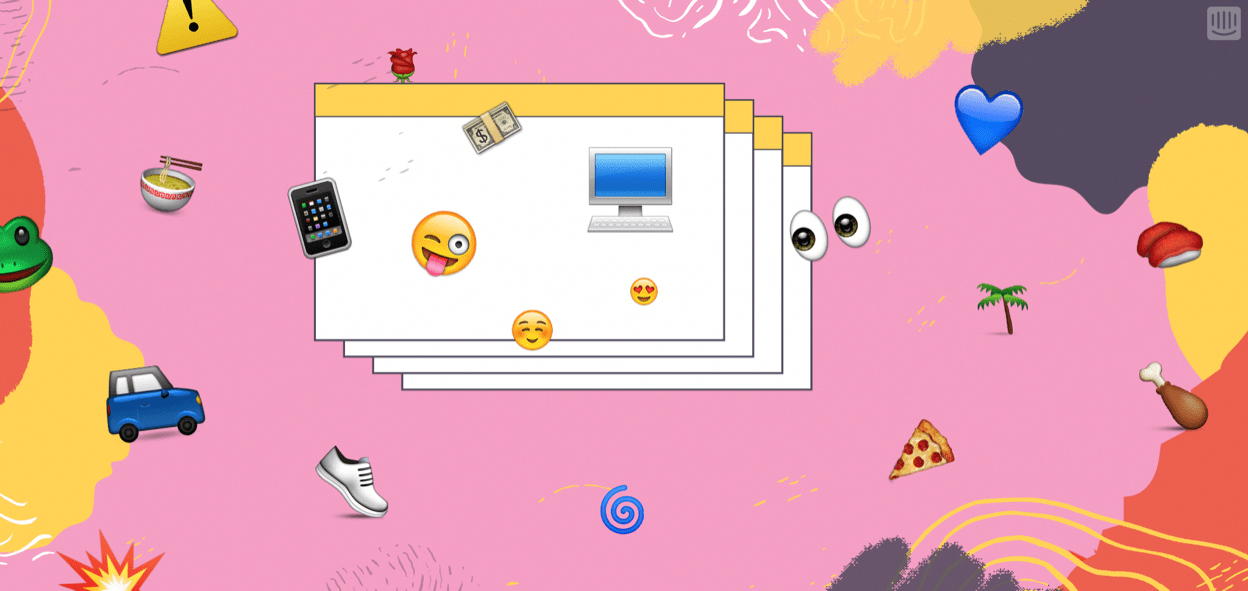
Your customers have mastered emoji. Now it’s your turn.
Main illustration: Kelly Carpenter
At Intercom, we’re always curious about how messaging shapes the way we communicate online with customers and website visitors. We’d be remiss if we ignored the 😍, the 👍, the 💙, the…emoji.

For our first data report, we analyzed emoji trends abstracted from more than two million anonymized* conversations that took place between our customers and their end users during a 3-month period, from June to August in 2015 and 2016.
Here are a couple things that surprised us the most, and how we make sense of them.
Emojis improve message engagement 🚀
It’s easy to dismiss emoji as silly and perhaps unprofessional but we discovered that they add real value to messages. Messages started by a business that contained an emoji were four times more likely to elicit a response from a consumer than those that didn’t. Yes, 4x more likely!
So if your job is to engage skeptical leads, consider how an emoji might soften your voice and tone and in turn prompt a response:

The Top 20 emoji and why mirroring matters
The 20 most common emoji found in messages in 2016 were quite similar to ones you might use in your personal life:

Category-wise, over a half (51%) of the top 20 emoji fall under a facial category, followed by object-based emoji, such as 🚀 (18%). As you might expect in a business setting, money-related emoji also featured (11%). Lots of business talk being conducted through the Messenger.
Things get more interesting when you take this analysis a little further. We wondered if the top 20 emoji used by our customers mirrored those used by their end users.
In real-life communication, mirroring is super important. When we’re positively engaged in a conversation, our body language, facial expressions, voice and tone, even breathing patterns, subconsciously start to resemble each other. Mirroring indicates both parties are listening, understanding, empathizing, and building rapport.
In theory, if businesses were truly connecting with their end users, we should find similar types of emoji in the top emoji used by businesses and consumers. Here’s what we found instead:

Consumers used facial emoji 30% more than businesses did (83% vs. 51%); businesses stuck to objects (18%) and money symbols (11%), neither of which show up in the consumer list.
The top 20 consumer list looks more like top emoji used by Twitter or consumer messaging apps, suggesting that end users communicate with businesses in similar ways than they do in their personal communication lives. They are highly expressive, personal and emotive. On the other hand, businesses keep emotion out of their messages, perhaps thinking it’s more professional. Even internally some of our teams are most comfortable using emoji like 🚀👍🐱.
To emote, or not to emote?
As messaging becomes the predominant way for businesses to talk to customers, surpassing social media and even email by some studies, it should come as no surprise the emoji we use, love, even pay for when we message our friends and family, have crept into business messaging conversations. Emoji aren’t a phenomenon – they’re literally digital representations of facial expressions, body language, gestures, etc., that have existed in real-life communication since the dawn of time.
Emoji aren’t going away anytime soon, and what the data shows is that businesses still have some work to do to use them more appropriately. If your goal is to form genuine, lasting relationships with your customers, it behooves you to develop an approach that feels natural and personal, rather than artificial, or worse, cheesy.
- Emote like a human. A good rule of thumb for the emoji-ambivalent is to start sparingly (same rule applies to exclamation marks!) and choose ones that reflect your genuine emotion. If a customer says something that makes you smile, insert a 😊. When an issue is fixed, using something such as a 🚀 speaks volumes and carries a lot of weight (there’s a great vibe in celebrating, that immediately makes customers feel positively about the news you’ve given them).
- Avoid negative emoji. A 😞 is almost as bad as saying “unfortunately” or “I’m afraid” – it seems too apologetic. By employing an 👌 instead, it seems like work is being done without overtly promoting it as a resolved situation (like a 👍 will do in the right place)..
- It doesn’t work in every context. If their first message to you sounds formal or angry, an emoji will only make things worse. Other topics where you want to avoid using emoji include billing, bug reports, or apologies. Also, if you’ve used an emoji and their reply didn’t contain one, get back to plain text.
Emoji aren’t a new “phenomenon” by any means. In the past few years they’ve overtaken our mobile keyboards, our tweets, Slack messages, dictionaries, even museums. While their “official” origins date back to Japan in 1999, conceptually, they go back even further. To you and I. To our smirks and hand gestures, our loving eyes and victory dances.
That said, what’s only become apparent in recent years is their value in business messages. Whether you emote or not, the key takeaway from all this serious emoji business is that communicating with consumers will increasingly resemble personal communication. It is up to businesses to figure out how to make their “work persona” align better with their “real one.”
This post only shares half of our findings! Click here to download the full data report to learn more. We’d be grateful if after reading it you shared it with friends and colleagues.
*We take our customers’ privacy very, very seriously. The data used for our analysis did not contain any identifiable information. Read our privacy policy.







